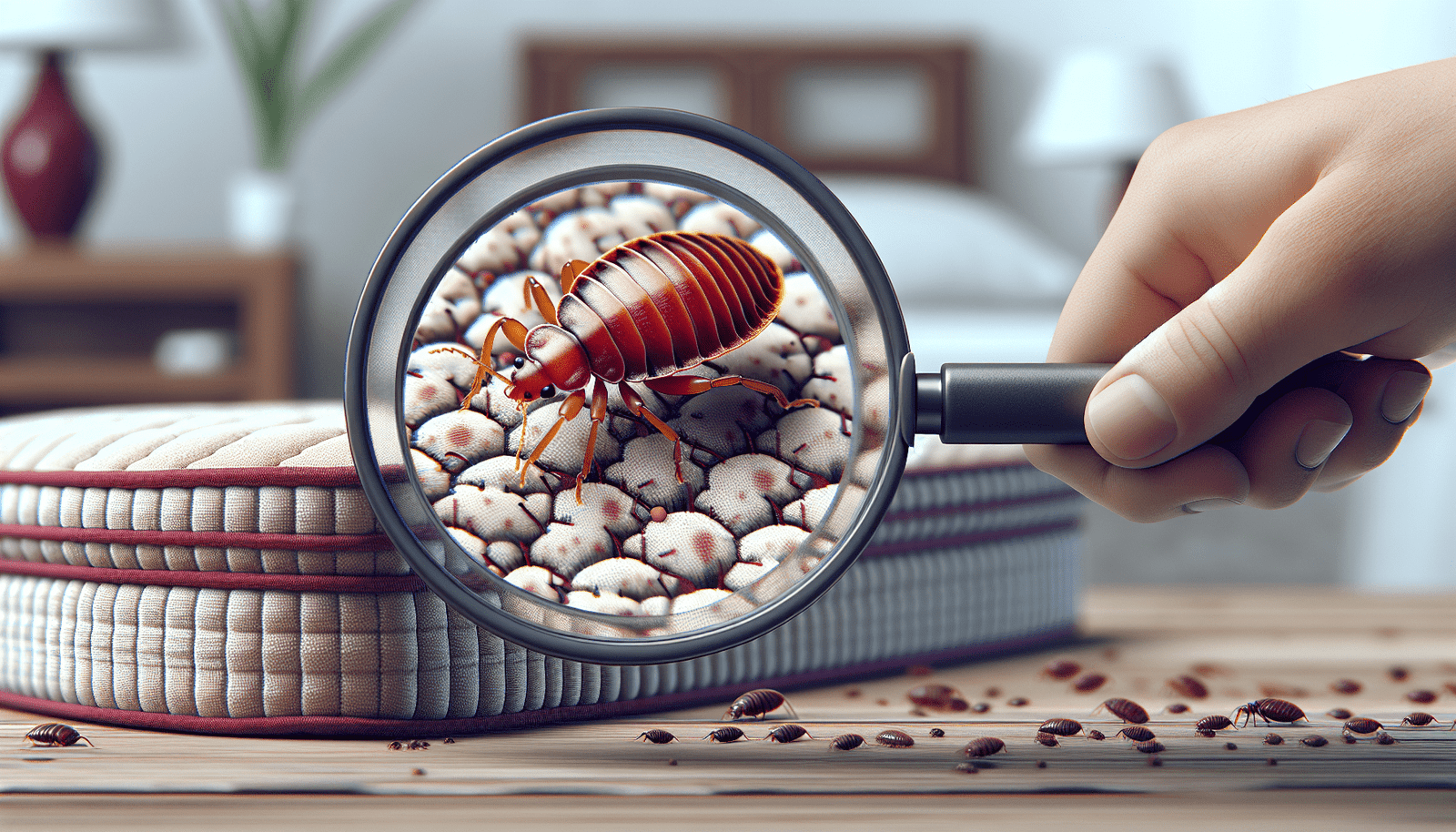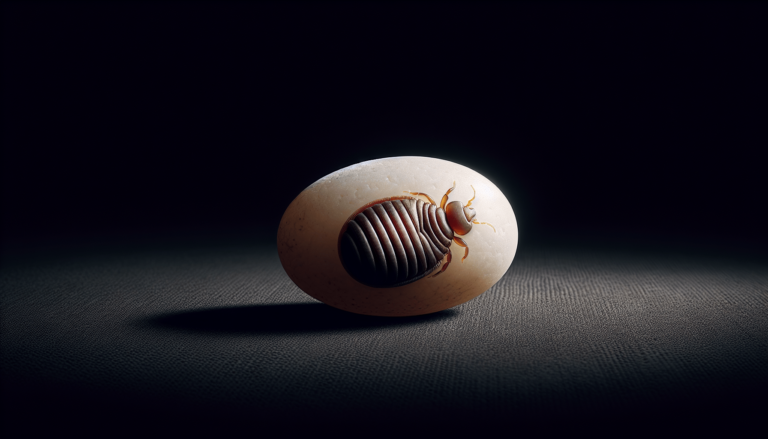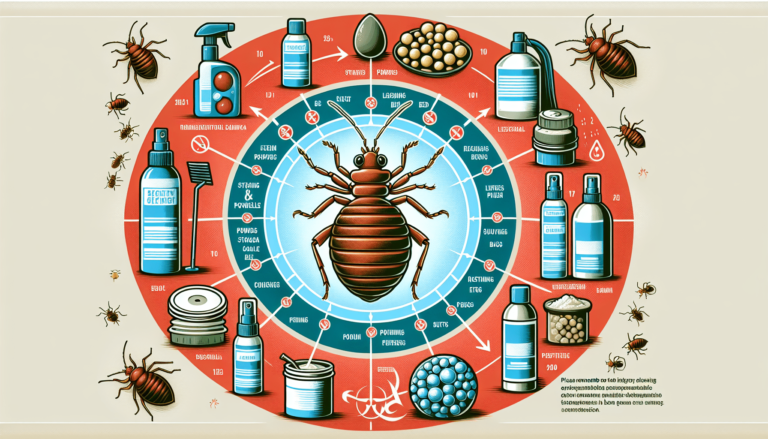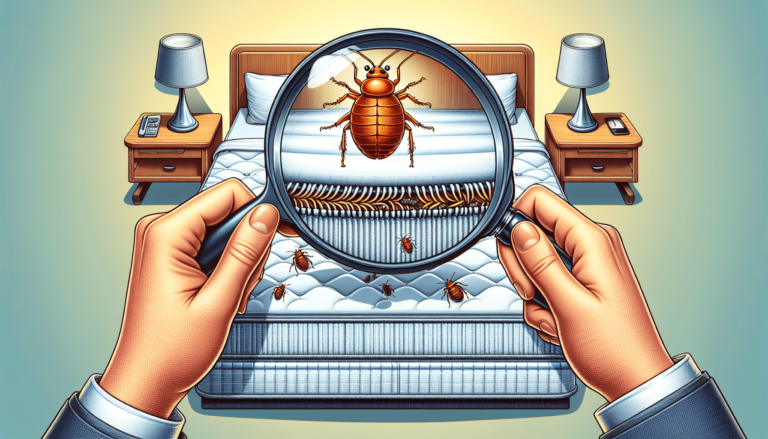How to Check for Bed Bugs and Identify an Infestation
If you wake up with itchy red welts on your skin and notice tiny black spots on your mattress, it is crucial to act quickly. In this article, we will guide you through the process of checking for bed bugs and identifying an infestation. With our expert advice and step-by-step instructions, you will gain the knowledge and tools necessary to effectively detect these pesky creatures. By familiarizing yourself with the signs of bed bug presence, you can take the appropriate measures to eliminate them from your home and prevent future infestations. So, whether you are a homeowner, renter, or simply concerned about the possibility of bed bugs, this comprehensive guide will equip you with the skills to tackle this common issue.

Understanding the Basics of Bed Bugs
Bed bugs are small, parasitic insects that feed on the blood of humans and animals. They are oval-shaped and reddish-brown in color, with a flat body that allows them to hide in cracks and crevices. Identifying features of bed bugs include their size, which is usually around 5-7mm in length, and their distinctively unpleasant odor, described as a musty, sweet scent.
The lifecycle of bed bugs
Understanding the lifecycle of bed bugs is crucial in effectively dealing with an infestation. Bed bugs go through a process known as incomplete metamorphosis, which consists of three main stages: egg, nymph, and adult. Female bed bugs can lay up to 5-7 eggs in a single day, and these eggs will hatch in about 6-10 days. The nymphs, or immature bed bugs, will then undergo several molting stages before reaching adulthood, during which they require a blood meal to progress.
Typical habits of bed bugs
Bed bugs are primarily nocturnal creatures, preferring to come out and feed on their hosts while they sleep. They are attracted to body heat and carbon dioxide, which are indicators of a potential food source nearby. Although they are commonly associated with beds and mattresses, bed bugs can also infest other furniture, such as couches and chairs, as well as cracks in walls and floorboards. They are excellent at hiding and can go unnoticed for long periods, making early detection challenging.
Signals of a Bed Bug Infestation
Detecting a bed bug infestation early on is crucial in preventing further spread and eliminating them effectively. There are several indicators to look out for:
Unusual bites on your skin
One of the most common signs of a bed bug infestation is waking up with unexplained bites on your skin. These bites often appear in a straight line or clustered pattern and can be accompanied by itchiness and redness. It’s important to note that bed bug bites are not always easily distinguishable from other insect bites, so it’s essential to consider other signs as well.
Spotting exoskeletons or egg shells
As bed bugs grow and molt through their lifecycle, they shed their exoskeletons, leaving behind empty shells. These exoskeletons are translucent and can often be found in the vicinity of their hiding spots, such as mattress seams, crevices, and cracks. Additionally, bed bugs also lay tiny, white eggs, which are about the size of a pinhead. These eggs are usually found in clusters and may be attached to surfaces using a sticky substance.
Locating small dark spots on bedding or mattresses
Bed bugs leave behind fecal matter, which appears as small dark spots on bedding, mattresses, or other surfaces they infest. These spots are often concentrated in areas where bed bugs hide or congregate, such as the seams of mattresses or along the edges of furniture. If you notice these spots, it’s a strong indication of a bed bug infestation and warrants further inspection.
Conducting a Thorough Inspection for Bed Bugs
To effectively inspect your living space for bed bugs, it’s crucial to know where to look and what to look out for. Here are some key steps to follow:
How to inspect your bed effectively
Start by thoroughly examining your bed, as this is the primary area where bed bugs are often found. Check the seams, tufts, and folds of your mattress, paying close attention to any signs of bed bug activity, such as live bugs, exoskeletons, or dark spots. It’s also important to inspect the bed frame, headboard, and footboard, as bed bugs can hide in cracks and crevices.
Checking other furniture and corners of the room
While bed bugs are commonly associated with beds, they can also infest other furniture, such as couches, chairs, and bedside tables. Inspect these pieces of furniture thoroughly, paying attention to joints, seams, and any other areas where bed bugs may hide. Don’t forget to check corners, baseboards, and electrical outlets, as bed bugs can squeeze into even the tiniest of spaces.
Signs to look out for in usual and unusual places
Bed bug infestations can extend beyond the bedroom, so it’s essential to be thorough in your inspection. Look for signs of bed bugs in unusual places, such as behind picture frames, under loose wallpaper, inside electrical appliances, or even in books. Bed bugs are excellent at hitchhiking, so it’s crucial to inspect your belongings if you’ve recently traveled or brought in second-hand furniture.
Using Bed Bug Traps and Interceptors
Bed bug traps and interceptors are useful tools in both detection and prevention of bed bug infestations. Here’s what you need to know:
What are bed bug traps and interceptors
Bed bug traps are devices designed to attract and capture bed bugs. They typically use a combination of heat, carbon dioxide, and a sticky surface to lure these pests into the trap, preventing them from reaching their host. Intercepting devices, on the other hand, are placed under the legs of furniture and act as a barrier, preventing bed bugs from climbing up.
How to use bed bug traps for detection
To use a bed bug trap for detection, place it strategically near areas suspected of bed bug activity, such as the legs of your bed or furniture. Follow the manufacturer’s instructions for optimal placement and check the traps regularly for any signs of bed bug activity. Traps can help provide early detection and alert you to the presence of bed bugs so that you can take appropriate action.
Analyzing the results of traps and interceptors
Once you’ve set up traps and interceptors, it’s important to analyze the results. If you find bed bugs trapped inside the devices, it’s a clear indication of an infestation. Monitoring the number of bed bugs caught can also help gauge the severity of the infestation and guide your next steps. Remember to keep a record of your findings, as this information may be useful if you decide to seek professional pest control services.
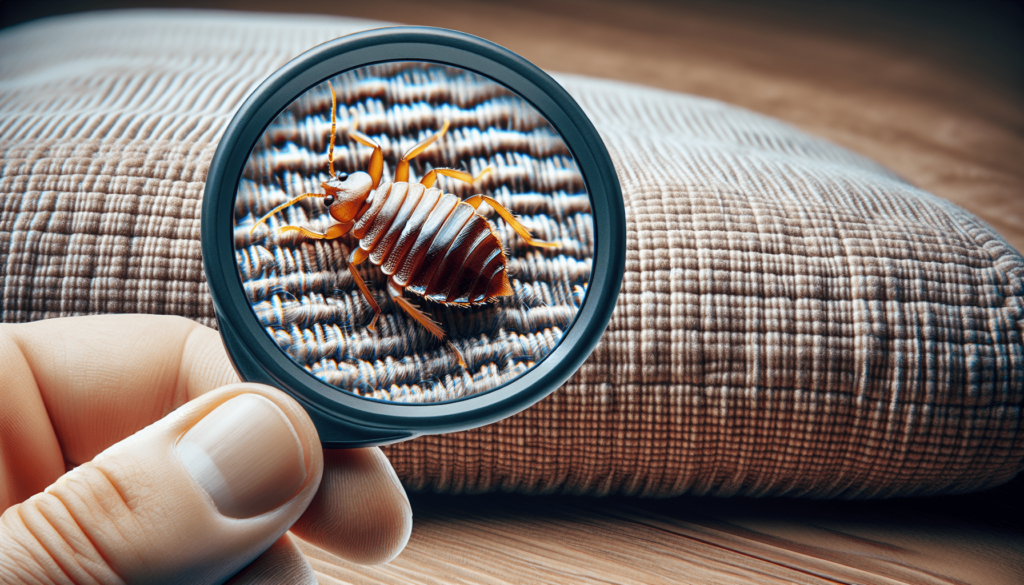
Hiring Professional Pest Control Services
While DIY measures can be effective in small-scale infestations, severe or persistent bed bug infestations often require professional assistance. Here’s what you need to know about hiring professional pest control services:
When to consider hiring a professional
If your bed bug infestation persists despite your best efforts, it may be time to consider hiring a professional pest control service. Additionally, if you have a large infestation, or if you live in a multi-unit building where bed bugs can easily spread between units, professional intervention is highly recommended. Professional pest control services have the expertise and equipment necessary to tackle even the most challenging infestations.
Selecting a reputable pest control service
When selecting a pest control service, it’s important to do your research and choose a reputable company. Look for companies that are licensed and insured, as this ensures they meet the necessary industry standards. Additionally, read reviews and ask for recommendations from friends or neighbors who have dealt with bed bug infestations in the past. A reputable pest control service will provide a thorough inspection, treatment plan, and follow-up visits to ensure the infestation is fully eradicated.
Understanding the process of professional bed bug removal
Professional bed bug removal typically involves a multi-step process. The initial step is a thorough inspection of the infested area to determine the extent of the infestation. This is followed by the treatment phase, which may include the use of insecticides, heat treatments, or a combination of both. Depending on the severity of the infestation, multiple treatments may be required. Finally, follow-up visits are essential to ensure the infestation has been successfully eradicated and to address any lingering issues.
Preventing Bed Bug Infestation
Preventing bed bug infestations is essential to protect your home and ensure your peace of mind. Here are some preventative measures to consider:
Keeping your living space clean
Maintaining a clean and clutter-free living space can help reduce the chances of a bed bug infestation. Regularly vacuum your floors, especially in areas where you spend a lot of time, such as the bedroom and living room. Pay close attention to cracks, crevices, and furniture seams where bed bugs may hide. Additionally, regularly wash and dry your bedding, curtains, and other fabrics on high heat to kill any potential bed bugs or their eggs.
Using protective covers on your mattress and box spring
Encasing your mattress and box spring in protective covers can create a barrier between you and any potential bed bugs. These covers are made of a special material that bed bugs cannot penetrate, effectively trapping them and preventing them from infesting your bed. Look for covers specifically designed for bed bugs and ensure they are labeled as “bed bug-proof” or “bed bug certified” for optimal protection.
What to do when returning from travels
Bed bugs are skilled hitchhikers and can easily infest your luggage and clothing while you’re traveling. To prevent bringing bed bugs home, carefully inspect your luggage and belongings before leaving your hotel room. Wash and dry your clothes on high heat as soon as you return home, as this will kill any potential bed bugs or eggs. If you suspect your luggage may have been infested, consider placing it in a sealed plastic bag until it can be thoroughly inspected and treated.
Understanding the Health Risks of Bed Bugs
While bed bugs are primarily a nuisance, they can also pose certain health risks. Here’s what you need to know:
Physical health risks associated with bed bugs
The primary physical health risk associated with bed bugs is the possibility of developing itchy, red welts from their bites. While bed bug bites are generally harmless and don’t transmit diseases, they can cause discomfort, irritation, and allergic reactions in some individuals. Additionally, excessive scratching of bites can lead to secondary bacterial infections if the skin is broken. If you experience severe allergic reactions or if bites become infected, seek medical attention.
Mental and emotional impact of a bed bug infestation
Bed bug infestations can take a toll on your mental and emotional well-being. The presence of these pests can cause anxiety, sleep disturbances, and increased stress levels. The feeling of being invaded in your own home can be overwhelming, leading to feelings of embarrassment and isolation. It’s important to seek support from friends, family, or professionals if you’re struggling with the emotional impact of a bed bug infestation.
Bed bugs and other diseases
While bed bugs are not known to transmit diseases directly, there have been rare cases where they have been associated with the transmission of certain pathogens. For example, bed bugs have been found to carry antibiotic-resistant bacteria, such as MRSA, as well as parasites like Chagas disease. However, the risk of disease transmission from bed bugs is considered extremely low, and they are not considered a significant public health threat in this regard.
Removing Bed Bugs with DIY Treatments
If you prefer to tackle a bed bug infestation on your own, there are several DIY treatments you can try. However, it’s essential to approach these methods with caution and be aware of their limitations:
Popular Do-It-Yourself bed bug treatments
Some popular DIY treatments for bed bugs include the use of bed bug sprays, dusts, and steamers. Bed bug sprays and dusts are insecticides that can be applied directly to areas where bed bugs hide, such as seams, cracks, and crevices. Steamers, on the other hand, use high-temperature steam to kill bed bugs and their eggs. These DIY treatments can be effective in small infestations or as part of a comprehensive treatment plan.
Safety precautions when using DIY treatments
When using DIY treatments for bed bugs, it’s crucial to prioritize safety. Follow the instructions provided by the manufacturer carefully and wear protective clothing, such as gloves and a mask, to prevent exposure to insecticides or steam. Keep children and pets away from treated areas and ensure proper ventilation in the room. If you’re unsure about using DIY treatments, it’s always best to consult with a professional pest control service.
Effectiveness and pros and cons of DIY treatments
DIY treatments can be effective in eliminating bed bugs in small, localized infestations. They offer a cost-effective solution and provide homeowners with a sense of control over the situation. However, it’s important to consider their limitations. DIY treatments may not be as effective in large infestations or in hard-to-reach areas. Bed bugs can also develop resistance to certain insecticides over time, reducing their effectiveness. Additionally, DIY treatments require patience, persistence, and regular monitoring to ensure complete eradication.
Helpful Tools and Resources on Bed Bugs
When dealing with a bed bug infestation, having access to helpful tools and resources can make a significant difference. Here are some recommendations:
Recommended books on bed bug detection and removal
- “The Bed Bug Survival Guide” by Jeff Eisenberg
- “Bed Bug Battles: The Expert’s Guide to Winning the War on Bed Bugs” by Jin Yu
These books provide in-depth information on bed bug detection, prevention, and treatment options. They can serve as valuable resources for homeowners and professionals alike.
Websites and forums offering support and advice
- National Pest Management Association (NPMA) – npmapestworld.org
- BedBugger – bedbugger.com
- Reddit – r/Bedbugs – reddit.com/r/Bedbugs
These websites and online forums provide a wealth of information, advice, and support from individuals who have experienced bed bug infestations firsthand. Reading and participating in these communities can offer valuable insights and guidance throughout your bed bug journey.
Detailed guides and visual aids for identifying bed bugs
- Environmental Protection Agency (EPA) – epa.gov/BedBug
- University of Minnesota Extension – extension.umn.edu/bedbugs
The EPA and University of Minnesota Extension websites offer comprehensive guides and visual aids for identifying bed bugs, their habits, and effective treatment options. These resources can help you become better informed and more confident in dealing with bed bug infestations.
Dealing with the Aftermath of a Bed Bug Infestation
Once you have successfully eradicated a bed bug infestation, it’s crucial to take steps to clean and restore your home, address any psychological effects, and prevent future infestations. Here’s what you need to know:
Cleaning and restoring your home
After bed bug treatment, thoroughly clean and vacuum your home to remove any dead bed bugs, eggs, or exoskeletons. Launder all fabrics, bedding, and clothing on high heat to kill any remaining bed bugs or eggs. Consider using a steam cleaner to treat areas that cannot be laundered, such as upholstery or mattresses. Remember to inspect and treat all furniture and cracks in walls and floorboards to ensure any remaining bed bugs are eliminated.
Potential psychological effects and how to cope
Dealing with a bed bug infestation can have a significant impact on your mental and emotional well-being. It’s essential to address any anxiety, stress, or negative emotions that may arise as a result. Seek support from friends, family, or professionals if needed. Engaging in self-care activities, such as exercise, hobbies, or relaxation techniques, can also help alleviate stress and promote emotional healing.
Preventing future infestations
After going through the ordeal of a bed bug infestation, it’s crucial to take preventative measures to avoid future infestations. Regularly inspect your living space for any signs of bed bugs, such as bites, dark spots, or exoskeletons. Practice good hygiene and cleanliness by regularly cleaning, vacuuming, and washing bedding and fabrics on high heat. When traveling or bringing in second-hand furniture, carefully inspect for any signs of bed bugs before bringing them into your home. By remaining vigilant, you can minimize the risk of another infestation.
In conclusion, understanding the basics of bed bugs, recognizing the signals of an infestation, conducting thorough inspections, utilizing bed bug traps and interceptors, considering professional pest control services, taking preventative measures, being aware of the health risks, considering DIY treatments, exploring helpful tools and resources, and dealing with the aftermath of an infestation are all crucial aspects of managing and preventing bed bug infestations. By being informed and proactive, you can protect your home and ensure a comfortable living environment for you and your loved ones.
Quiz:
- What are some identifying features of bed bugs?
- How can you detect a bed bug infestation?
- What are some common habits of bed bugs?
- When should you consider hiring professional pest control services for a bed bug infestation?
- What are some preventative measures to prevent bed bug infestations?
